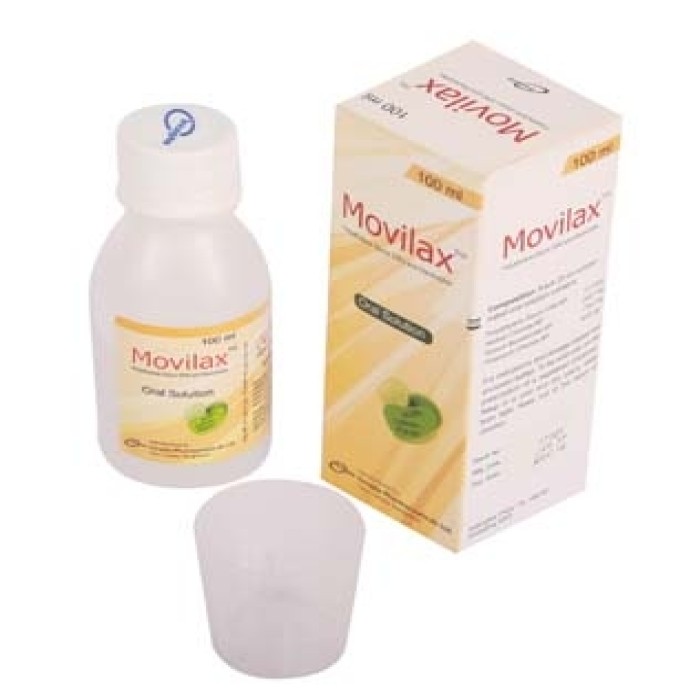accepted your request

Movilax Oral Solution
SkU: 1258
Description
Composition
Each 25 ml concentrated oral solution contains-
- Polyethylene Glycol 3350: 13.125 gm
- Sodium Chloride: 350.7 mg
- Sodium Bicarbonate: 178.5 mg
- Potassium Chloride: 46.6 mg
Each sachet (Powder for Suspension) contains-
- Polyethylene Glycol 3350: 13.125 gm
- Sodium chloride: 350.7 mg
- Sodium Bicarbonate: 178.5 mg
- Potassium Chloride BP 46.6 mg.
Indications
For effective relief from constipation and treatment of chronic constipation. Resolving fecal impaction.
Therapeutic Class
Osmotic purgatives
Pharmacology
Polyethylene Glycol 3350 exerts an osmotic action in the gut, which induces a laxative effect. Polyethylene Glycol 3350 increases the stool volume, which triggers colon motility via neuromuscular pathways. Electrolytes combined with Polyethylene Glycol 3350 are exchanged across the intestinal barrier (mucosa) with serum electrolytes and excreted in fecal water without net gain or loss of sodium, potassium and water.
Sodium chloride is the major extracellular cation. It is important in electrolyte and fluid balance, osmotic pressure control and water distribution as it restores sodium ions. It is used as a source of electrolytes and water for hydration, treatment of metabolic acidosis, priming solution in haemodialysis and treatment of hyperosmolar diabetes. It is also used as diluents for infusion of compatible drug additives.
Sodium bicarbonate raises blood and urinary pH by dissociation to provide bicarbonate ions, which neutralises the hydrogen ion concentration. It also neutralises gastric acid via production of carbon dioxide.
Potassium chloride is a major cation of the intracellular fluid. It plays an active role in the conduction of nerve impulses in the heart, brain and skeletal muscle; contraction of cardiac skeletal and smooth muscles; maintenance of normal renal function, acid-base balance, carbohydrate metabolism and gastric secretion.
Dosage & Administration
For adults and children aged 12 years and above: (Powder for Suspension)
- Constipation: The dose is 1 sachet daily. This may be increased to 2-3 sachets daily, if required.
- Fecal Impaction: 8 sachets daily, consumed within 6 hours. A course of treatment for fecal impaction does not normally exceed 3 days.
- Patients with renal insufficiency: No dosage change is necessary for treatment of either constipation or fecal impaction.
- Direction of use: Each sachet should be dissolved in 125 ml water. For fecal impaction 8 sachets may be dissolved in 1 litre of water. Store the solution refrigerated and discard any solution not used within 6 hours.
For adults and children aged 12 years and above: (Oral Solution)
- Constipation: 25 ml of Polyethylene Glycol 3350 and electrolytes oral solution added to 100 ml of water once daily (to make a total volume of 125 ml). This may be increased to 2-3 doses of 25 ml daily (each 25 ml dose added to 100 ml of water), if required according to individual response.
- Fecal Impaction: 8 doses of 25 ml daily (each 25 ml dose added to 100 ml of water). A course of treatment for fecal impaction does not normally exceed 3 days.
- Direction of use: 25 ml of oral solution added to 100 ml of water (to make a total volume of 125 ml). Any unused diluted solution should be discarded within 24 hours.
Interaction
No specific drug interactions have been found.
Contraindications
Polyethylene Glycol 3350 and electrolytes is contraindicated in patients with known hypersensitivity to the active substance or any of the excipients, intestinal perforation or obstruction, crohn’s disease and ulcerative colitis.
Side Effects
Generally well tolerated. However side effects like allergic reactions, electrolyte disturbances particularly hyperkalaemia and hypokalaemia, abdominal pain, diarrhea, headache, peripheral edema may appear.
Pregnancy & Lactation
Use in Pregnancy: There is no experience of the use of Polyethylene Glycol 3350 during pregnancy and lactation. It should only be used if considered essential by the physician.
Use in Lactation: It is unknown whether Polyethylene Glycol 3350 is excreted in human breast milk.
Precautions & Warnings
Patients with impaired cardiovascular function: For the treatment of fecal impaction the dose should be divided so that no more than two sachets are taken in any one hour.
If patients develop any symptoms indicating shifts of fluid/electrolytes (e.g. edema, shortness of breath, increasing fatigue, dehydration, cardiac failure) Movilax should be stopped immediately and any abnormality should be treated appropriately. Prolonged use with all laxatives is undesirable and may lead to dependence.
Overdose Effects
Severe pain or distention can be treated by nasogastric aspiration. Extensive fluid loss by diarrhea or vomiting may require correction of electrolyte disturbances.
Storage Conditions
Store below 30° C and in a place protected from light. Do not refrigerate.
Reviews
Composition
Each 25 ml concentrated oral solution contains-
- Polyethylene Glycol 3350: 13.125 gm
- Sodium Chloride: 350.7 mg
- Sodium Bicarbonate: 178.5 mg
- Potassium Chloride: 46.6 mg
Each sachet (Powder for Suspension) contains-
- Polyethylene Glycol 3350: 13.125 gm
- Sodium chloride: 350.7 mg
- Sodium Bicarbonate: 178.5 mg
- Potassium Chloride BP 46.6 mg.
Indications
For effective relief from constipation and treatment of chronic constipation. Resolving fecal impaction.
Therapeutic Class
Osmotic purgatives
Pharmacology
Polyethylene Glycol 3350 exerts an osmotic action in the gut, which induces a laxative effect. Polyethylene Glycol 3350 increases the stool volume, which triggers colon motility via neuromuscular pathways. Electrolytes combined with Polyethylene Glycol 3350 are exchanged across the intestinal barrier (mucosa) with serum electrolytes and excreted in fecal water without net gain or loss of sodium, potassium and water.
Sodium chloride is the major extracellular cation. It is important in electrolyte and fluid balance, osmotic pressure control and water distribution as it restores sodium ions. It is used as a source of electrolytes and water for hydration, treatment of metabolic acidosis, priming solution in haemodialysis and treatment of hyperosmolar diabetes. It is also used as diluents for infusion of compatible drug additives.
Sodium bicarbonate raises blood and urinary pH by dissociation to provide bicarbonate ions, which neutralises the hydrogen ion concentration. It also neutralises gastric acid via production of carbon dioxide.
Potassium chloride is a major cation of the intracellular fluid. It plays an active role in the conduction of nerve impulses in the heart, brain and skeletal muscle; contraction of cardiac skeletal and smooth muscles; maintenance of normal renal function, acid-base balance, carbohydrate metabolism and gastric secretion.
Dosage & Administration
For adults and children aged 12 years and above: (Powder for Suspension)
- Constipation: The dose is 1 sachet daily. This may be increased to 2-3 sachets daily, if required.
- Fecal Impaction: 8 sachets daily, consumed within 6 hours. A course of treatment for fecal impaction does not normally exceed 3 days.
- Patients with renal insufficiency: No dosage change is necessary for treatment of either constipation or fecal impaction.
- Direction of use: Each sachet should be dissolved in 125 ml water. For fecal impaction 8 sachets may be dissolved in 1 litre of water. Store the solution refrigerated and discard any solution not used within 6 hours.
For adults and children aged 12 years and above: (Oral Solution)
- Constipation: 25 ml of Polyethylene Glycol 3350 and electrolytes oral solution added to 100 ml of water once daily (to make a total volume of 125 ml). This may be increased to 2-3 doses of 25 ml daily (each 25 ml dose added to 100 ml of water), if required according to individual response.
- Fecal Impaction: 8 doses of 25 ml daily (each 25 ml dose added to 100 ml of water). A course of treatment for fecal impaction does not normally exceed 3 days.
- Direction of use: 25 ml of oral solution added to 100 ml of water (to make a total volume of 125 ml). Any unused diluted solution should be discarded within 24 hours.
Interaction
No specific drug interactions have been found.
Contraindications
Polyethylene Glycol 3350 and electrolytes is contraindicated in patients with known hypersensitivity to the active substance or any of the excipients, intestinal perforation or obstruction, crohn’s disease and ulcerative colitis.
Side Effects
Generally well tolerated. However side effects like allergic reactions, electrolyte disturbances particularly hyperkalaemia and hypokalaemia, abdominal pain, diarrhea, headache, peripheral edema may appear.
Pregnancy & Lactation
Use in Pregnancy: There is no experience of the use of Polyethylene Glycol 3350 during pregnancy and lactation. It should only be used if considered essential by the physician.
Use in Lactation: It is unknown whether Polyethylene Glycol 3350 is excreted in human breast milk.
Precautions & Warnings
Patients with impaired cardiovascular function: For the treatment of fecal impaction the dose should be divided so that no more than two sachets are taken in any one hour.
If patients develop any symptoms indicating shifts of fluid/electrolytes (e.g. edema, shortness of breath, increasing fatigue, dehydration, cardiac failure) Movilax should be stopped immediately and any abnormality should be treated appropriately. Prolonged use with all laxatives is undesirable and may lead to dependence.
Overdose Effects
Severe pain or distention can be treated by nasogastric aspiration. Extensive fluid loss by diarrhea or vomiting may require correction of electrolyte disturbances.
Storage Conditions
Store below 30° C and in a place protected from light. Do not refrigerate.
Store Location: Mirpur
Home Delivery: 30 TK
Delivery Time: Around 06 hours
Cash On Delivery Available
Warranty:
View Cart

